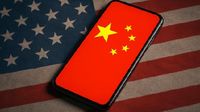In a significant escalation of trade tensions between the United States and China, the Chinese government has halted the export of crucial rare earth elements and their magnets as a retaliatory measure against increased tariffs imposed by the U.S. This decision, announced on April 4, 2025, has sent shockwaves through global supply chains, particularly affecting industries reliant on these essential materials, including automobiles, semiconductors, and aerospace.
The backdrop to this development is the ongoing trade war that has seen the Trump administration impose a staggering 145% tariff on Chinese products. In response, China has enacted its own tariffs, reaching 125% on U.S. goods. The recent export restrictions specifically target six types of heavy rare earth metals, including dysprosium, terbium, and lutetium, as well as the magnets made from them. This move is poised to disrupt the supply chain for many industries that depend heavily on these materials.
Rare earth elements are vital for the production of electric vehicles, drones, robotics, and various military technologies. Approximately 90% of these elements are produced and refined in China, making the nation a dominant player in the global market. The new regulations mean that without a special export license, shipments of these critical materials will not be approved, raising concerns among manufacturers worldwide.
As of now, dysprosium oxide is trading at around $204 USD per kilogram in Shanghai, with prices expected to be higher in international markets. However, many U.S. companies find themselves inadequately prepared, as they have historically kept minimal inventory to manage costs. This lack of stockpiling could lead to production halts if the export restrictions persist. In contrast, some Japanese firms have learned from a previous export halt in 2010 related to the Senkaku Islands dispute and have maintained over a year’s worth of inventory.
In addition to economic implications, China's export controls also raise national security concerns. The country has started prohibiting transactions with American military-related companies, which could further strain relations between the two nations. James Litinsky, CEO of MP Materials, the only rare earth mine operating in the U.S., warned that the technologies involved in drones and robotics will be central to future warfare, highlighting the potential risks to America’s military supply chains.
Meanwhile, the Chinese General Administration of Customs reported a 20.31% increase in rare earth exports in March 2025 compared to the previous year, totaling 5,666.3 tons. However, this increase has been overshadowed by the effective halt in exports that began on April 4. According to insiders, the approval process for export licenses is opaque and can take anywhere from six weeks to several months, leaving many exporters in limbo.
One rare earth trader in China noted the uncertainty surrounding shipping timelines, stating that when customers inquire about when their shipments could depart, they often estimate a timeline of about 60 days, though this could extend significantly. If the export freeze continues for more than two months, typical customer inventories are likely to run dry, leading to widespread shortages.
The geopolitical ramifications of these export controls are significant. They not only showcase China's ability to leverage its dominance in rare earth production but also highlight the vulnerabilities of countries that rely heavily on these materials. Analysts suggest that while China may be using its export controls as a weapon in the trade war, this strategy might backfire in the long term, as it could prompt other countries to diversify their sources of rare earths away from China.
As the situation unfolds, the global community watches closely. The implications of these trade tensions extend beyond economics, touching on issues of national security, environmental concerns, and the future of international trade relationships. The ability of China to control the supply of rare earths may force a reevaluation of supply chains across multiple industries, potentially reshaping the landscape of global trade.
In conclusion, the recent halt of rare earth exports by China marks a critical juncture in the ongoing trade war with the United States. The effects of this decision will reverberate through various sectors, prompting industries to reassess their dependencies and seek alternative sources. As both nations navigate this complex landscape, the stakes have never been higher, not just for their economies but for global stability as a whole.





